Gorilla Glue is undoubtedly one of the most prominent adhesive brands to have gained global recognition due to its strength and versatility. Still, the question arises whether it is really the strongest adhesive. Whether you are simply fixing things, doing DIY tasks, or working in construction professionally, having the proper knowledge about the different types of adhesives and their properties can significantly influence your work. In this guide, we will analyze bonding solutions stronger than Gorilla Glue, examining their characteristics, applications, and performance in various situations. By the conclusion of this article, not only will you know which adhesive is suitable for your purpose, but you might also come across other products that surpass this widely used glue.
Understanding Gorilla Glue
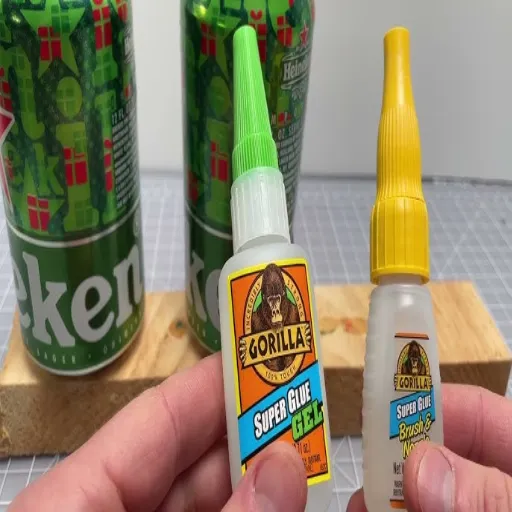
Gorilla Glue polyurethanes are adhesives that are exceptionally strong and very versatile. Its primary function is to bond materials together and then cure at a higher temperature, ensuring a strong bond that can be used with a wide range of materials, including wood, metal, ceramic, stone, and many more. Since it is water-resistant, the glue can be used indoors and outdoors, and it is beneficial for projects that require a long-lasting stronghold. But, it enforces the surface preparation that includes moisture activation for proper performance. It is very powerful, though, but it may not be the right choice for rubbery materials or quick fixes, as it requires a curing period to achieve its full strength.
Key Features of Gorilla Glue
- Strong Bond Strength: Gorilla Glue is among the most powerful adhesives ever, featuring the ability to bond a wide range of materials, including glass, metal, wood, and more; ultimately, it provides a durable, high-strength hold.
- Waterproof Formula: The glue is a waterproof formula, allowing it to be used for both indoor and outdoor applications, especially in cases of humidity or changing weather conditions.
- Versatile Usage: The adhesive is so versatile that its applications cover a wide range, starting from home repairs and DIY projects to professional-grade industrial uses.
- Expands for a Tight Bond: Gorilla Glue expands upon curing, creating a bond that is both tight and strong, while also filling any tiny cracks and gaps in the materials.
- Temperature Resistant: It tolerates harsh and extreme weather conditions, as well as significant temperature fluctuations, while remaining effective in both hot and cold conditions.
- Long-lasting Durability: Whenever Gorilla Glue dries, it becomes very tough and instills a durable bond that is even stronger than the pressure applied, thus guaranteeing the durability of your projects.
Applications for Gorilla Glue
Gorilla Glue is a multipurpose adhesive that can be used in numerous applications across various projects. In cases related to home renovation, arts and crafts, or woodwork, Gorilla Glue is one of the most essential tools for making strong and trustworthy connections. For instance, the glue’s remarkable ability to stick to various materials, including wood, metal, stone, ceramic, and foam, makes it suitable for a wide range of situations, such as repairing furniture, reattaching broken ceramics, or building DIY projects. Moreover, being water-resistant, it extends the range of use to outdoor applications, such as fixing up garden lights or performing maintenance on tools that will be used outside. Such a reliable, precise, plus durable glue has been a staple in the hands of hobbyists and professionals covering an infinite number of scenarios.
Comparing Gorilla Glue with Other Adhesives
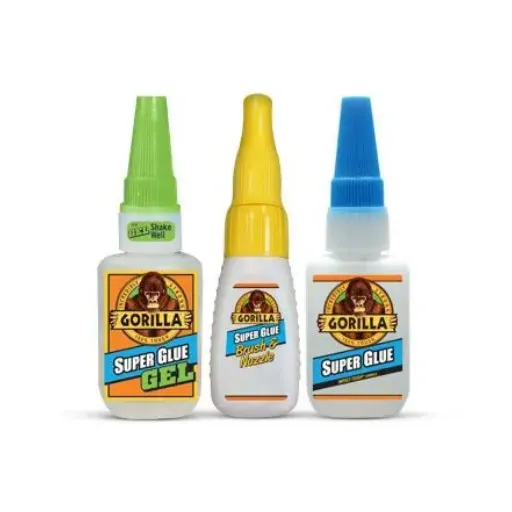
Gorilla Glue’s exceptional versatility and strength make it the frontrunner in the adhesive world. Gorilla Glue is not a standard glue that works only with certain materials; instead, it is a powerful adhesive that is compatible with almost everything in the house, including wood, metal, stone, and ceramic. If one uses it outdoors, its water-resistant properties will come in handy as the email glue will not stick during rainy days. Furthermore, Gorilla Glue’s expansion during curing forms a permanent bond, whereas some other glues may lose their grip over time. As a result of these factors, Gorilla Glue is considered a trustworthy option for both insignificant domestic repairs and highly professional projects with strict requirements.
Super Glue vs Gorilla Glue
Here’s a concise comparison table based on the latest information:
| Parameter | Super Glue | Gorilla Glue |
|---|---|---|
| Bonding Strength | Strong for small repairs | Stronger for heavy-duty applications |
| Drying Time | Quick-drying (seconds) | Slower (1-2 hours) |
| Material Compatibility | Best for non-porous materials | Works on porous and non-porous |
| Water Resistance | Limited | Highly water-resistant |
| Durability | Brittle under stress | Durable and long-lasting |
| Ease of Use | Simple, no mixing required | Expands, requires careful application |
| Best Use Cases | Small, quick fixes | Heavy-duty, versatile projects |
| Temperature Resistance | Moderate | High resistance |
| Flexibility | Rigid bond | Expands and fills gaps |
| Cost | Generally cheaper | Slightly more expensive |
Epoxy: Strengths and Applications
Epoxy can effectively join things together and is the strongest, most durable, and most resistant adhesive to extreme conditions. A mixture of resin and hardener makes epoxy a powerful adhesive that can withstand extremely hot and cold temperatures, high-pressure areas, and environments where chemical exposure is everyday. Its strength and versatility have made it the number one choice in the industrial sector, where the most demanding applications, such as aerospace, automotive, and construction projects, are typically found.
On the other hand, epoxy is not just a material for industry; it is also a dexterous helper at home for repairs and creativity. For example, sealing leaks in water pipes and creating intricate art pieces are both within the realm of epoxy, as it can easily adhere to diverse surfaces such as metal, wood, plastic, and glass. Furthermore, its water-resistance and gap-filling characteristics make it even more suitable for outdoor repairs and waterproofing jobs. Still, good preparation, mixing, and application are the secrets to getting the best results. Whether it’s a challenging or artistic project, epoxy remains a dependable and strong solution that can be used in various applications.
Real-Life Applications for Stronger Alternatives
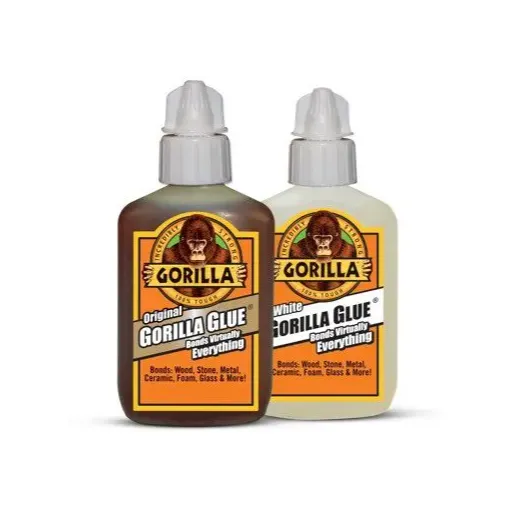
Polyurethane adhesives, as well as methyl methacrylate (MMA), which are stronger than epoxy, have been a significant choice in industry-demanding sectors. These sectors comprise:
- Aerospace and Automotive: These adhesives are ideal for bonding components such as aircraft parts and automobiles, which undergo frequent vibrations and impacts, due to their durability and resistance to such conditions.
- Construction: Used for reinforcing or repairing critical infrastructures like bridges, the floor above, and the columns supporting the floor.
- Marine Applications: The adhesives are effective for sealing and repairing boats, as they offer the best water resistance and flexibility under stress.
- Industrial Manufacturing: The adhesives are used for joining heavy machinery and other applications where extreme strength and resilience are required.
Industrial Uses of Adhesives
Adhesives, or glues, if you prefer, are essential in various factories and companies, and even contribute to making the end product better. The automotive, aerospace, construction, and electronic industries benefit most from the application of modern adhesives. To illustrate, the automotive sector attaches different parts of the car with adhesives, resulting in a lighter vehicle that is more fuel-efficient. Likewise, the use of powerful adhesives in the aerospace industry means that new planes can be made from less material but stronger ones, which is crucial for both safety and performance. In the case of electronics, the use of adhesives enables the assembly of tiny parts with great precision, thereby making the long-overdue miniaturization and functional longevity possible. The proper adhesive solution, however, is still being sought, and thus the demand for adhesives in the industry is growing, primarily due to eco-friendliness and efficiency.
Woodworking Projects
Woodworking projects have gained a lot of attention lately, as more and more people want to express their creativity and take on do-it-yourself (DIY) challenges. For starters, the list of such projects includes creating uncomplicated shelves, birdhouses, or planters, which provide beginners with an opportunity to gain hands-on experience with essential cutting, measuring, and assembling. On the other hand, professional woodworkers typically inquire about creating more complex pieces, such as furniture or cabinets, thereby emphasizing the need for accurate and robust joinery, as well as long-lasting finishes. Additionally, the current woodworking style places a strong emphasis on the use of reclaimed timber, which aligns with green practices while lending the finished pieces a distinct character.
Pros and Cons of Different Adhesives
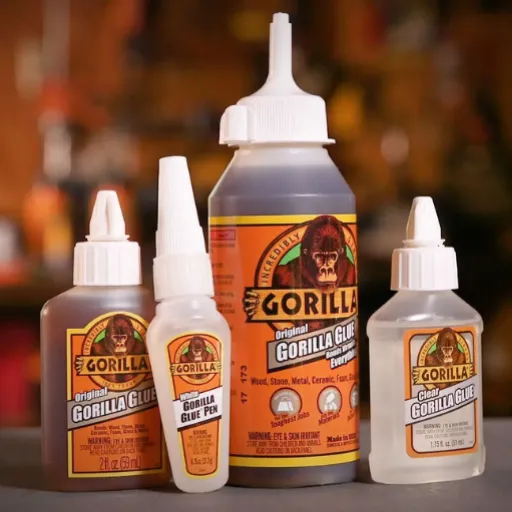
When selecting adhesives for woodworking, each type comes with its own unique benefits and drawbacks. PVA glue, also known as wood glue, is strong, inexpensive, and easy to clean up, but it won’t resist water unless it is specifically labeled as waterproof. Epoxy exhibits powerful and gap-filling properties, making it ideal for forming strong bonds, although it can be messy and requires precise mixing. Cyanoacrylate glue, also known as super glue, has a quick bonding time and is suitable for minor repairs; however, it is fragile and not the best choice for larger joints. Lastly, polyurethane glue is adaptable and moisture-resistant, but it swells as it sets; therefore, a conscientious application is necessary. The decision on which adhesive to use is based on the project’s specific requirements and environmental conditions.
Gorilla Glue: Strengths and Weaknesses
Strengths
Gorilla Glue has been one of the best adhesives due to its remarkable bonding ability and numerous applications. Its most significant advantage is that it can adhere to various substrates, including wood, metal, ceramics, foam, glass, and others. This is why it is widely used in a range of projects. Moreover, its waterproof characteristics make it suitable for use both outdoors and indoors, providing durability even in the most unfavorable conditions. Additionally, Gorilla Glue’s curing process involves expansion, resulting in a tighter grip and more effective filling of gaps.
Weaknesses
However, the very property that gives Gorilla Glue its stronghold can also be considered a disadvantage if not appropriately manipulated; over-expansion can sometimes lead to a mess or misplacement of the joints. Additionally, the superior adhesive strength can be a problem when it comes to cleaning—it may be necessary to grind or scrape the dried glue. Additionally, its curing time is longer than that of other fast-adhesives, which may not be suitable for time-sensitive projects. Nevertheless, Gorilla Glue is still a go-to choice in cases where accuracy and power are the primary concerns.
Epoxy: Advantages and Disadvantages
Advantages
Epoxy is a multifunctional adhesive that has gained considerable popularity due to its remarkable strength and durability. One of the significant benefits of epoxy is its ability to bond to a wide range of materials, including wood, metal, plastic, and ceramics. This property makes it a universal choice for both industrial and DIY projects. It is resistant not only to chemicals and water but also to high temperatures, making it suitable for very tough environments. It is even more advantageous because the user can customize the epoxy’s properties by mixing it with additives that alter its flexibility, color, or texture.
Disadvantages
On the other hand, there are a few drawbacks that one should be aware of. The process of mixing epoxy’s resin and hardener components usually entails a lot of precision, which can make it a bit difficult for inexperienced users to handle. Furthermore, it also has a comparatively long curing period, and if the adhesive is not handled correctly during this stage, poor results may be obtained. Moreover, the fumes released from the epoxy resin can be pretty intense during application, necessitating proper ventilation and safety measures. Nevertheless, these disadvantages do not overshadow the fact that in scenarios where strength and durability are essential, epoxy remains one of the most durable glues.
Practical Tips for Choosing the Right Adhesive
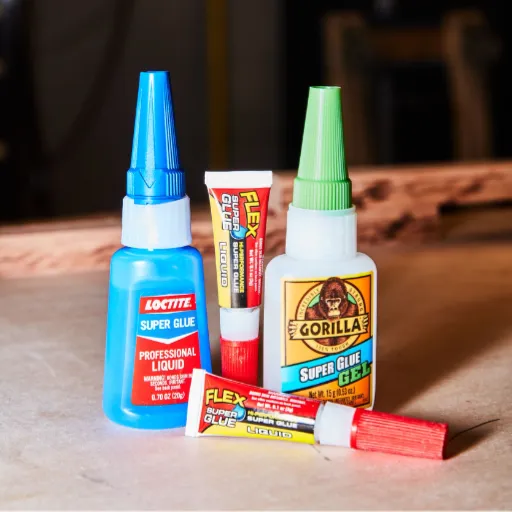
- 1
Consider the Materials Being Bonded
Choose an adhesive specifically designed for the materials you are working with, such as hardwood, plastic, metal, or glass. - 2
Evaluate Strength Requirements
You need to determine the strength of the bond. For heavy-duty applications, consider using strong adhesive products like epoxy or polyurethane. - 3
Check for Environmental Resistance
Suppose the adhesive joint is going to be subjected to water, high temperature, or chemical agents. In that case, the selection must be made from the powerful resistance adhesives, such as waterproof or heat-resistant types. - 4
Account for Setting and Curing Times
Based on your project schedule, select an adhesive with a curing time that aligns with your needs. Instant adhesives may be suitable for minor tasks, whereas others may require a longer curing time to achieve full strength. - 5
Prioritize Ease of Application
For a novice working on a small project, the adhesive should have an application method that is easy to follow, such as the pre-mixed type or adhesives with built-in applicators.
Material Compatibility Considerations
Selecting the correct adhesive and understanding the compatibility between materials are crucial to ensure a strong bond and long-lasting results. Various materials, such as wood, plastic, metal, or glass, bond in their own way, and the effectiveness of the bond varies depending on the type of adhesive used. For example, cyanoacrylate glue is an excellent adhesive for non-porous surfaces, such as plastic or metal, but may not work well on porous or flexible surfaces, like fabric. On the contrary, epoxies are great multipurpose adhesives that can be used on many types of surfaces; however, they may require precise mixing and curing. If you are uncertain, always refer to the manufacturer’s specifications and conduct small tests on your materials. This will help you identify the ideal adhesive for your project and ensure its optimal performance.
Environmental Factors to Keep in Mind
When it comes to adhesives, it is crucial to consider the environmental factors that may impact their performance. One of those factors is temperature, and accordingly, some adhesives become weaker under high or low temperatures. Equally, humidity may damage the adhesive’s setting, particularly in the case of those that are moisture-sensitive or designed for specific weather conditions. Another factor to consider is UV exposure, as some adhesives may become less durable and their bond strength may decrease after prolonged exposure to sunlight. Besides that, you should always consider the adhesive’s environmental impact, preferring low-VOC or eco-friendly choices whenever possible, to reduce adverse effects not only on health but also on the planet. These factors are crucial for delivering projects with the desired quality and reliability in the long run.
Evaluating Application Requirements
In assessing application prerequisites, my primary concern is to clearly understand the project’s requirements, including the materials to be used, the expected performance, and the environment in which it will be implemented. I give first preference to choosing adhesives that meet these conditions, but I also consider safety, eco-friendliness, and the durability of the bond over time.
Reference Sources
To support the accuracy of your article on adhesives, three authoritative and professional sources are mentioned below:
- Adhesion and Adhesives: Science and Technology
This book presents a comprehensive study of adhesive science, covering formulations and applications for the most demanding use cases. - Adhesives in Engineering
A scientific paper that analyzes the participation of adhesives in engineering applications, including their strength and performance in different conditions. - Structural Adhesives: Chemistry and Technology
The book explores structural adhesives, their chemistry, and applications in high-performance settings. It also serves as a good reference for comparing adhesives.
Frequently Asked Questions (FAQs)
What is Gorilla Glue?
Gorilla Glue is a polyurethane-based adhesive known for its strong bonding capabilities. It expands as it cures, making it ideal for porous materials like wood and certain plastics. This glue is often used for various DIY projects due to its versatility and durability.
How Does Gorilla Glue Compare to Super Glue?
Gorilla Glue and super glue serve different purposes. Super glue, such as Loctite Super Glue, provides a quick bond and works best for non-porous materials. In contrast, Gorilla Glue is better suited for porous materials and requires moisture to activate. The choice between the two depends on the type of project and materials being used.
What Type of Glue is Best for Wood Projects?
For wood projects, Gorilla Glue is often recommended due to its ability to effectively bond wood fibers. However, super glue gel can also be helpful for quick fixes or smaller joints. The ideal glue will depend on the specific requirements of your project.
Can I Use Gorilla Glue on Plastic?
Gorilla Glue can bond certain plastics, but it is not ideal for all types. For plastic parts, Loctite super glue or a polyurethane-based adhesive may provide stronger bonding without the risk of damage. Always check the compatibility of the glue with the type of plastic you are using.
What Are the Practical Applications of Super Glue?
Super glue is often used for quick repairs on various materials, including plastic, metal, and wood. Its fast-setting nature makes it suitable for projects where time is a factor, but it may not provide the same strength as Gorilla Glue in specific applications.
How Do I Clean Up Excess Glue?
To clean up excess glue, it’s best to use a solvent that is compatible with the adhesive. For Gorilla Glue, water can help if it’s still wet, while acetone is effective for super glue. Always clean the surface before applying any adhesive to ensure optimal adhesion.
What is the Working Time for Gorilla Glue?
The working time for Gorilla Glue is approximately 10-20 minutes, depending on the materials and conditions. It’s essential to clamp the materials together during this period to achieve a strong bond. After curing, it can take up to 24 hours to reach full strength.
Is Hot Glue Stronger Than Gorilla Glue?
Hot glue is generally not as strong as Gorilla Glue. While hot glue can be effective for lightweight materials and quick projects, Gorilla Glue offers a stronger bond for heavy-duty applications, especially with porous materials like wood.
Which Glue is Best for DIY Projects?
The best glue for DIY projects depends on the materials involved. For versatile use, Gorilla Glue is excellent for wood and porous materials, while super glue is ideal for quick repairs on plastic and metal. Assessing the materials to be joined will help in making the right adhesive choice.



















